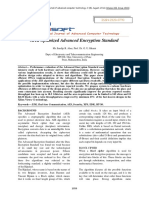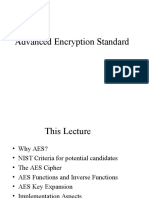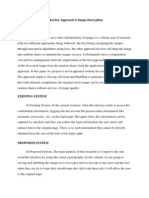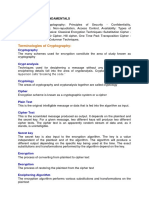AES (Advanced Encryption Standard) is one of the most widely used symmetric-key encryption
algorithms
developed by National Institute of Standards and Technology (NIST)
1. How AES Works
AES operates using a symmetric key, meaning the same key is used for both
encryption and decryption. It is based on the Rijndael cipher,
AES supports key sizes of 128, 192, or 256 bits and processes data in blocks of 128
bits.
The encryption process involves several rounds of transformations
Key Expansion:
�AES starts by expanding the original encryption key into a series of round keys (a
key schedule). This is done using a key expansion algorithm.
Initial Round:
AddRoundKey: The first step in AES encryption is XORing the plaintext block with
the first round key.
Main Rounds (Repeated for 9 rounds for AES-128, 11 rounds for AES-192, and 13
rounds for AES-256):
SubBytes: Each byte of the state is substituted with a corresponding byte from the
S-box (a fixed substitution table). This adds non-linearity to the cipher.
ShiftRows: The rows of the state are shifted cyclically. The first row remains
unchanged, the second row shifts by one byte, the third by two bytes, and the
fourth by three bytes.
MixColumns: The columns of the state are mixed to provide diffusion (spreading
out the influence of each byte over multiple bytes).
AddRoundKey: The state is XORed with the round key derived from the original
key.
Final Round (Last round has no MixColumns step):
SubBytes, ShiftRows, and AddRoundKey.
The result after the final round is the ciphertext.
. AES Decryption
AES decryption is essentially the reverse of the encryption process. It uses the
same key but applies the inverse of each operation (Inverse SubBytes, Inverse
ShiftRows, Inverse MixColumns, etc.). The rounds are performed in reverse order,
starting from the last round key.
�3. Benefits of AES over Other Algorithms
AES has several advantages over other encryption algorithms, making it the
preferred choice in many applications:
a. Security
Strong Encryption: AES provides a high level of security. As of 2024, AES with 256-
bit keys is considered highly secure and resistant to brute-force attacks, while AES-
128 and AES-192 are also deemed secure.
No Known Effective Cryptanalysis: AES has been extensively analyzed by the
cryptographic community and, to date, no effective attacks against it have been
found (other than brute-force). It is considered secure against all practical attacks
when used properly.
Resistance to Known Attacks: AES is designed to withstand various cryptographic
attacks, such as linear and differential cryptanalysis, which were effective against
older algorithms like DES.
b. Efficiency
Fast Execution: AES is relatively fast, both in hardware and software. Its design
allows it to be efficiently implemented on modern processors with special
instructions for cryptographic operations (e.g., AES-NI on Intel and AMD
processors).
Low Resource Consumption: AES is highly efficient in terms of CPU and memory
usage, especially in constrained environments (e.g., mobile devices, embedded
systems).
Parallel Processing: AES can be implemented efficiently in parallel, improving its
performance on modern multi-core processors.
c. Scalability
AES supports multiple key sizes (128, 192, and 256 bits), allowing users to balance
�security and performance according to their needs. Higher bit sizes offer stronger
security but may incur a slight performance penalty.
d. Standardization and Adoption
Wide Acceptance: AES is the encryption standard recommended by NIST and is
widely adopted worldwide in security protocols such as HTTPS (SSL/TLS), IPsec
(VPNs), and more.
Interoperability: As a standardized algorithm, AES is supported by most
cryptographic libraries and tools, ensuring that encrypted data can be safely
exchanged across different systems.
e. Resistance to Quantum Computing
While no encryption algorithm is fully "quantum-proof," AES is relatively more
resistant to quantum attacks compared to older algorithms like RSA and DES.
Quantum computers may break RSA and ECC encryption, but AES with 256-bit
keys is considered relatively secure even in the face of quantum advancements,
although larger key sizes (e.g., AES-512) might eventually be needed in the future.
. Comparison to Other Algorithms
a. AES vs. DES
Security: DES uses a 56-bit key, which is now considered too small to withstand
modern brute-force attacks. AES, with its key sizes of 128, 192, and 256 bits, is far
more secure.
Speed: AES is faster than DES, especially in software implementations. DES
requires more rounds (16 rounds), while AES typically uses 10 to 14 rounds,
depending on the key size.
b. AES vs. Triple DES (3DES)
Security: 3DES applies the DES algorithm three times to each block of data, but it
is still vulnerable to certain attacks like the "birthday attack." AES, with its modern
�cryptographic design, provides stronger security with fewer rounds.
Efficiency: AES is much more efficient than 3DES. 3DES is slower, requires more
computational resources, and is less suitable for modern applications.
c. AES vs. RSA
Type of Algorithm: AES is a symmetric-key algorithm, meaning it uses the same
key for encryption and decryption. RSA, on the other hand, is an asymmetric
algorithm, meaning it uses a pair of keys (public and private).
Use Cases: RSA is typically used for key exchange or digital signatures, while AES is
used for bulk data encryption. In practice, RSA is often used to exchange AES keys
securely, and then AES is used for encrypting the actual data because of its
efficiency.
d. AES vs. Blowfish
Speed: AES tends to be faster than Blowfish, especially with larger keys (Blowfish
has a maximum key size of 448 bits).
Security: AES is more secure than Blowfish, as Blowfish has been found to have
potential weaknesses in its design that could make it less secure than AES.






















































































